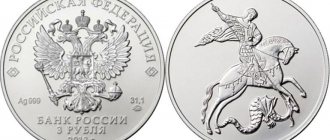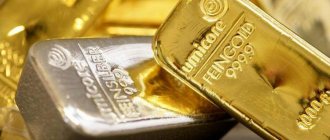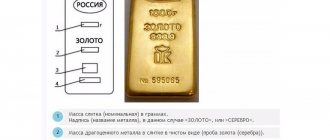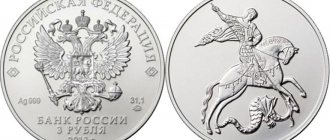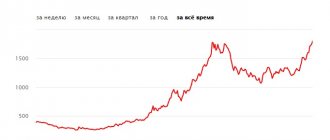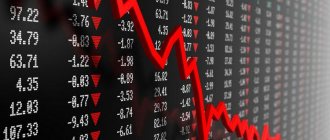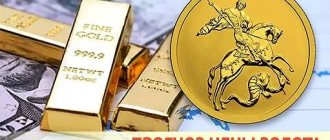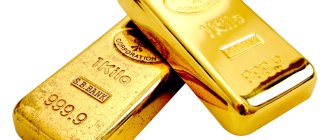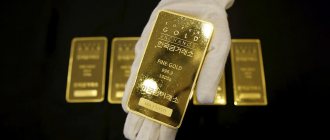Over the past decade, palladium has shown the greatest increase in value on world exchanges compared to other precious metals. This year, experts predict its further growth.
The reason for such strong growth is the fact that any connection regarding the cost of production of this precious metal has been broken. Representatives of Citigroup assure that with any corrections at the current level, palladium is an excellent purchase for future profitable transactions. At the beginning of this year, palladium reached its all-time high, and its main buyers are companies in the automotive industry, which use it in autocatalysts.
According to UBS estimates, over the past fifteen years, production of this metal has decreased by an average of twelve percent, while demand has increased by about four million ounces. Moreover, demand will continue to increase in the first half of this year due to new carbon emissions standards in India, China and Europe, as well as a surge in car sales.
What was the price trend for palladium over 10 years?
Palladium is a product that is subject to all laws of supply and demand. In addition to the constant factors that affect the cost of precious metals, palladium has some other factors that can influence the dynamics of its value. Financial market experts constantly record these factors.
South Africa and the Russian Federation account for about 80% of the world's palladium reserves. Any “stress” in these countries immediately affects the price of palladium.
It is possible to track the movement of palladium quotes using a chart that was compiled over a ten-year period. Analyzing it, you can see that the growth of rates began back in 2005, and later there was a decline due to the global crisis in 2008. However, after the crisis, quotes began to move exclusively upward, and in 2011-2013. its value has become difficult to predict due to various jumps.
Throughout 2010, the price of palladium increased from 4.25.7 to 788.6 USD per troy ounce. Over the next three years, these indicators created positive dynamics regarding the growth in the cost of palladium. Indeed, at the end of 2011 it cost 649.35 USD per ounce, a year later 697.3 USD, and in 2013 – 720.7 USD.
Palladium reached its peak in quotations six years ago, when in August its price was at $896.3 per ounce. After this, prices gradually began to decline, and were fixed at six hundred dollars per ounce.
At the same time, experts have noticed that today the trend towards increasing the cost of palladium has only been increasing over the past three and a half years. Indeed, this precious metal reached 1700 USD. The last breakthrough in value was this January, during which palladium added another thirty percent in value. According to experts, the upward trend in the price of palladium will continue, and it will reach 2,400 USD, and may even exceed it.
Analysts note that the current economic situation in the world and sales of automotive enterprises have the greatest influence on the quotes of this precious metal. In the case of economic recovery in the states that consume this metal, one can observe a pattern according to which the well-being of their population increases. This, in turn, leads to an increase in car production and, accordingly, the cost of palladium. Since there is no shortage of this metal, if any changes occur in this area, the largest producers may well be able to satisfy the current demand.
Palladium
Norilsk Nickel Palladium Fund placed tokens for carbon-neutral nickel in Vienna RUSSIA-NORNICKEL-NICKEL-TOKENS 09/06/2021 12:00:24
Moscow. 6 September. INTERFAX - Norilsk Nickel's Global Palladium Fund (MOEX: GMKN) (GPF) has listed digital exchange traded instruments (ETCs) backed by carbon-neutral nickel on the Vienna Stock Exchange, Norilsk Nickel announced on Monday. Carbon credits are allocated to these instruments, reflecting the reduction in greenhouse gas emissions due to Norilsk Nickel’s activities implemented in 2019-2020. The volume of these emissions was certified by the international auditor EY, and the calculation methodology was certified by the leading European consultant on environmental and sustainable development issues, Sphera GmbH, which has been working on accounting for Norilsk Nickel’s CO2 emissions since 2013. Norilsk Nickel planned to produce two batches of carbon-neutral nickel this year with a total volume of about 10 thousand tons, allocating in them a reduction in emissions of 60-70 thousand tons of carbon dioxide achieved in 2021-22. The new instrument is aimed at institutional investors and offers a low investment cost with an overall expense ratio of 0.75%. The minimum investment amount is $100 thousand, and daily quotes are available on the Vienna Stock Exchange, the statement explains. Prior to its release on the exchange, the carbon-neutral metal was tokenized on the Atomyze blockchain platform. The number of investors in this platform includes the majority shareholder of Norilsk Nickel - Vladimir Potanin. Norilsk Nickel's reduction in carbon dioxide emissions was made possible by modernizing the hydroelectric power station that powers Norilsk Nickel's production facilities in the Norilsk industrial region, updating and repairing energy equipment, introducing automated control and accounting systems, reducing heat losses in buildings and pipelines, and decommissioning outdated power units. . Norilsk Nickel strives to become a leader in metals by offering investors a portfolio of low-carbon raw materials that are a transparent and fully audited source in the chain of creation of metals that meet the requirements of sustainable development, said Anton Berlin, Vice President and Head of Sales and Commerce at Norilsk Nickel. “Investors now have the opportunity to gain low-cost access to nickel, which plays a critical role in the transition to clean energy sources, while being confident that it is mined and produced responsibly,” added GPF CEO Alexander Stoyanov. The carbon-neutral nickel ETC joins the fund's portfolio of six ETCs backed by gold, silver, platinum, palladium, nickel and copper. ETC of Norilsk Nickel received listings on the London, Frankfurt, Swiss and Italian stock exchanges. Bs ak
MOEX$#&: GMKN
Auto-repost. Read the blog >>>
Palladium price chart today + 45 years of quote history
Palladium is a rare and scarce metal, so its prices have been steadily rising over the past few years.
The bullish trend since 2021 has paused due to the coronavirus crisis, when palladium quotes fell to $1,500. However, in just a week, prices increased by several hundred dollars, and after a period of profit-taking, growth continued again in the summer of 2020: At the end of 2021, the price of palladium increased by another 28.5%, and it is difficult to say what should stop the growth in 2021. There have already been situations in history of explosive price increases, but not on such a large scale:
Chart source: macrotrends.net
Below you can download the data and graphs that I used in the article:
The last 10 years have been successful for palladium, prices have skyrocketed many times over. The graph is reminiscent of the Bitcoin cryptocurrency - the rate there also flies up/down by tens and even hundreds of percent.
The graph shows how palladium has been steadily rising in price since 2021; the only noticeable drop occurred in 2021 amid the coronavirus crisis. Prices have failed to reach their all-time high, but gradual growth continues.
Key moments in the history of the palladium market:
- 1980 - stock exchange speculators increased the prices of all precious metals several times.
- 1999 - the Euro-3 environmental standard was issued, which greatly increased the demand for palladium in the automotive industry.
- 2001 - the first boom in the 21st century, the rate reached $1000 per ounce. The subsequent collapse to $200 occurred against the backdrop of the dot-com crisis in the stock market.
- 2008 - the global financial crisis once again brought down prices.
- 2014 - the introduction of the Euro 6 standard, which seriously tightened emission standards for diesel engines and increased the need for palladium.
- February, 2021 - historical record price, $2,724 per ounce.
- March, 2021 - prices collapsed almost 2 times amid the coronavirus panic. By the beginning of 2021, the exchange rate had almost recovered.
If we compare prices in 1977 and 2021, we get a yield of 9% per annum - an excellent result! Unfortunately, rate fluctuations do not allow you to simply “invest and forget” about palladium - as the crisis years of 2001, 2008 and 2021 have shown, prices can drop by 50% or more at a moment.
In an investment portfolio, palladium can be safely used together with traditional gold; according to the calculation of the collation coefficient, there is practically no connection, the value is -0.13. The connection with stocks is stronger; with the American Dow Jones index the correlation is +0.84. Palladium is not suitable for diversifying the risks of stocks, but it is very suitable as an alternative to gold during a growing economy.
The gold+palladium portfolio shows excellent results historically:
Adding palladium to a portfolio only slightly increases the risks, but the profitability increases several times. The indicators for the worst day in history and the maximum drawdown remain within acceptable limits.
Investing in palladium is quite risky and there are often strong price movements. Price quotes strongly depend on the state of the world economy; during crises, the graph does not just fall - it flies down at a steep peak. When choosing an investment portfolio, palladium looks best as a complement to the calmer gold.
Dynamics and analysis of the global palladium market
Palladium, Palladium, [Pd] - element 46 in the periodic table, is named after the asteroid Pallas, discovered in 1801 by the German astronomer Heinrich Olbers.
The metal density is 12 g/cm³ - slightly heavier than silver. Palladium belongs to the noble and precious metals and is also part of the platinum subgroup. In its pure form it has a silvery color:
The metal was first discovered by the Englishman William Wollaston in 1803 during experiments with platinum ore.
The scientist did not intend to study a new chemical element, but he did not want to lose the authorship of the discovery, so he resorted to a trick. Representatives of the London Scientific Society began to receive anonymous leaflets entitled “Palladium or the New Silver,” which described the properties of the metal. There was also a mention of a store, which, again anonymously, received a package with a sample. To drum up interest, Wollaston announced a £20 reward for anyone who could produce the metal artificially. Naturally, no one succeeded. While interested scientists tried to uncover the deception, William Wollaston completed his research on platinum and began working on a new metal. In 1805, he announced the discovery and recognized himself as the author of the mysterious leaflets. What lengths will you go to to remain in the history of science!
Today, palladium plays a small but important role in the global economy. First of all, it is indispensable in the automotive industry; demand grows every year:
Chart source: platinum.matthey.com
In 2021, 85% of palladium is used in autocatalysts - devices for filtering vehicle exhaust gases. In the 1970s, countries began tightening vehicle emissions standards, most notably nitrogen oxide, one of the main components of smog in big cities. Palladium, unlike platinum, neutralizes N₂O well; it has become more often used in new cars.
The main consumer of palladium in 2021 and according to forecasts in the future is China, where the air in large cities is heavily polluted. The dynamics of demand are stable; more and more palladium is required for cars every year.
The remaining 15% comes from electronics and the production of medical instruments, as well as jewelry: both in pure form and in alloys such as white gold.
The graph shows that in industries other than the automotive industry, palladium consumption is falling. The metal has become too expensive, manufacturers are looking for alternatives wherever possible, for example, platinum, which is 40% cheaper today.
Palladium is mined in large quantities in 5 countries: Russia, USA, Canada, South Africa and Zimbabwe. The Russian company Norilsk Nickel ranks first in the world in production with a market share of 40%. The following places are occupied by companies from South Africa - Anglo Platinum (24%), Impala Platinum (13%), Sibanye-Stillwater (6%). Russia and South Africa are the main suppliers of palladium, see chart:
Despite constantly growing demand, neither country has been able to significantly increase production. The fact is that palladium is a by-product of the extraction of other metals. Companies from South Africa primarily specialize in platinum (80% of world production), and it has become much cheaper in recent years. Norilsk Nickel also has plenty of problems, although management has plans to increase palladium production.
The situation is partially saved by recycling; the dynamics over 8 years have been positive - an increase of 35%. In general, there has been a shortage of palladium on the market for several years, as can be seen from this graph:
The excess of demand over supply of palladium on the market has been observed since 2012. In 2021, the shortage of metal increased again, which led to a double increase in prices.
In the future, palladium will not lose its position. LMC Automotive predicts that gasoline-powered vehicles (where palladium is most used) will cease to be sold until 2035. The market will be captured by hybrids that still use fuel.
85% of palladium is used in the automotive industry. Demand is growing every year due to stricter requirements for vehicle exhaust gases. The supply of metal is not keeping pace with this growth. As a result, there has been a shortage on the market for many years, which provokes a constant rise in prices.
Why is palladium rising today? Price forecast for 2021
Should you invest in palladium in 2021? Of course it’s worth it, because its growth dynamics are the best among precious metals over the last 10 years, so you can and should consider it for your portfolio.
Factors that influence the palladium price forecast in 2021:
✅ Constant shortage of metal. The demand for palladium is growing much faster than its production, and this dynamic continues: in the mines in South Africa there are problems due to the coronavirus; in Russian Norilsk Nickel, add sanctions, the environment and reputational losses on top.
✅ Growth of the Chinese economy and eco-standard China-VI. The Middle Kingdom has recovered better than other countries from the coronavirus crisis and is ready to continue economic growth. In 2021, demand for cars is predicted to increase. Considering that, according to the China-VI standard introduced in 2021, 30% more palladium will be used in each new car, the demand for the metal will increase again
✅ Joe Biden's victory and his environmental policy. A day-one return to the Paris climate agreement and big green energy plans should lead to further tightening of U.S. vehicle emissions controls.
✅ Weakness of the dollar. The economic recession in the United States and trillion-dollar aid packages are putting pressure on the American currency. Accordingly, goods traded in dollars (including precious metals) rise in price.
❌ Continuation of the economic crisis. The global economy is holding up so far and is beginning to recover, but the possibility of new problems cannot be ruled out. This could be a vaccination failure, panic sales in overheated markets, or anything else. New problems could have a significant impact on palladium prices.
❌ High prices. Compared to historical prices, palladium today is trading at a high price, and it is becoming increasingly difficult to grow further. However, the example of Bitcoin showed: as long as there is demand, there is no price ceiling.
If we summarize all the pros and cons, we get the following forecast for palladium prices in 2021:
There are more than enough prerequisites for palladium prices to rise in 2021. Perhaps the only thing that can interfere is a possible second wave of the crisis associated with new covid problems or the weakness of the global economy.
Pessimistic forecast: $2000 per ounce Forecast according to my expectations: $2700 per ounce Optimistic forecast: $3500 per ounce
Now you understand why palladium has been growing for several years and you know my forecast for 2021. What about your expectations? Vote:

